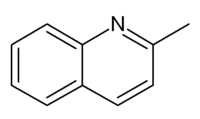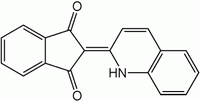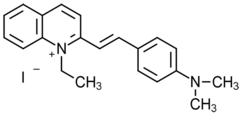Quinaldine
 | |
| Names | |
|---|---|
| IUPAC name
2-Methylquinoline | |
| Other names
Quinaldine, α-methylquinoline, chinaldine, khinaldin | |
| Identifiers | |
| 91-63-4 | |
| 3D model (Jmol) | Interactive image |
| ChEMBL | ChEMBL194931 |
| ChemSpider | 13870160 |
| ECHA InfoCard | 100.001.896 |
| EC Number | 202-085-1 |
| PubChem | 7060 |
| |
| |
| Properties | |
| C10H9N | |
| Molar mass | 143.19 g/mol |
| Appearance | colorless oil |
| Density | 1.058 g/cm3 |
| Melting point | −2 °C (28 °F; 271 K) |
| Boiling point | 248 °C (478 °F; 521 K) |
| Insoluble | |
| Hazards | |
| Main hazards | Harmful (Xn), Corrosive (C) |
| R-phrases | R21/22 R34 |
| NFPA 704 | |
| Flash point | 79 °C (174 °F; 352 K) |
| Except where otherwise noted, data are given for materials in their standard state (at 25 °C [77 °F], 100 kPa). | |
| | |
| Infobox references | |
Quinaldine or 2-methylquinoline is an organic compound with the formula CH3C9H6N. It is one of the methyl derivative of a heterocyclic compound quinoline. It is bioactive and is used in the preparation of various dyes. It is a colorless oil but commercial samples can be colored.[1]
Production
It is recovered from coal tar. It can be prepared from aniline and paraldehyde via Skraup synthesis or from aniline and crotonaldehyde via Doebner-von Miller variation of the Skraup reaction.[1]
Uses
Quinaldine is used in anti-malaria drugs, in manufacturing dyes, food colorants (e.g., Quinoline Yellows, pinacyanol), pharmaceuticals. It is the precursor to the pH indicator Quinaldine Red.


Quinaldine sulfate is an anaesthetic used in fish transportation.[2] In some Caribbean islands it is used to facilitate the collection of tropical fish from reefs.
Quinaldine has critical point at 787 K and 4.9 MPa and its refractive index is 1.8116.
References
- 1 2 Gerd Collin; Hartmut Höke (2005), "Quinoline and Isoquinoline", Ullmann's Encyclopedia of Industrial Chemistry, Weinheim: Wiley-VCH, doi:10.1002/14356007.a22_465
- ↑ Blasiola G. C. Jr. (1977). "Quinaldine sulphate, a new anaesthetic formulation for tropical marine fishes". Journal of Fish Biology. 10 (2): 113–119(7). doi:10.1111/j.1095-8649.1977.tb04048.x. Retrieved 2007-07-16.
